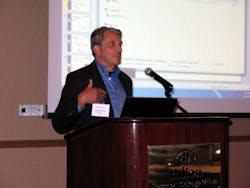Industrial Ethernet: Panel Discusses Protocol Differences
In the last session of the Manufacturing Track at The Automation Forum 2012, Automation World ’s Co-Founder & Editor in Chief Gary Mintchell got what he has long wanted: a discussion with representatives from each of the major Ethernet-based networking protocols sitting side by side and answering questions. The packed room of attendees seemed happy with the result.
Panelists included Chuck Lukasik, director of the CC-Link Partner Association (www.cclinkamerica.org) discussing CC-Link IE Field; Joey Stubbs, North American representative, EtherCAT Technology Group (www.ethercat.org); Rich Harwell, chief technology officer for ODVA (www.odva.org) and advanced solutions manager at Eaton, representing Ethernet/IP protocol; Shaun Kneller, key accounts manager at B&R Industrial Automation, representing Ethernet PowerLink (www.ethernet-powerlink.org); Carl Henning, deputy director of PI North America (www.us.profibus.com), discussing Profinet; and Scott Hibbard, vice president for technology for factory automation at Bosch Rexroth Corp., representing Sercos North America (www.sercos.com).
Panelists had a chance to present information on the similarities and differences among their networks in terms of structure, speed, applications and industry support. But all agreed Ethernet is has been a useful addition to the industrial automation landscape. “The standardization of the hardware is a significant advancement with an advantage to users,” said Lukasik. “But TCP/IP is not a solution that fits all situations.”
>> Click here to watch an excerpt of the Industrial Ethernet panel discussion at The 2012 Automation Conference.
Kneller concurred: “The thing about standard Ethernet is that it doesn't answer all the questions, so people are going to develop a better solution.”
That's why Ethernet, which was touted as the great equalizer and the solution to the fieldbus wars, is now showing up in variations. Despite the frustration users and machine builders may feel having to sort through all the variations, “competition is a good thing,” said Henning. “An advancement by one kind of pushes the others to also make advances. Energy management is an area where we're all going now, for example.”
Hibbard quipped that he thought the panel “was about 12 bodies short” if you count the Ethernet variants by the number of specifications registered with the IEC. “Cost impact, node impact and many other issues affect which one you choose. But rather than take the tack of 'its my way or the highway,' the next important step is for us to work together.” His Sercos III network uses CIP Safety as its safety protocol, and last year with ODVA the Sercos organization announced a Machinery Initiative whose goal is to make it easier for machine builders to use multiple networks.
Differences
The protocol differences can be significant. ODVA's Harwell explained that with EtherNet/IP, one of the CIP network protocols, “all Ethernet traffic is carried by TCP/IP or UDP on standard unmodified Ethernet. That allows a coexistence of traffic, and also the opportunity to ride the train of Ethernet.”
Kneller said the developers of Ethernet PowerLink, on the other hand, “decided on a slot protocol, which eliminates collisions—similar to CC Link—and lets us remove and reconnect hardware without performance change. It delivers fast, predictable and dependable cycle time. And we can do both wire or ring redundancy and everything would still work, similar to EtherCAT.”
Stubbs described the structure of EtherCAT as “Ethernet on the fly. We read or write to the frames without stopping to get the best speed. We like to say you can't ever have too fast of a fieldbus.” He added that EtherCAT does this using 100 megabit physical connections: “EtherCAT performance does not require a leap to Gigabit Ethernet,” he said.
PowerLink's Kneller said, “We realize EtherCAT is a fast network. We respect it. But specmanship is difficult thing. Personally, I think determinism is much more important than network speed.”
Protocol representatives also used their network's extent of industry support as differentiators. Henning said, “Profinet is not just Profibus put into an Ethernet frame, but they do share organizations and resources. In terms of community, we have 44 competence centers around the world. They're there to support the technology for end users and vendors.” Other network providers cited the number of member partners they had, and other evidence of support both in the U.S. and around the world.
Lukasik told how CC Link IE Field can exchange data between field (production) level and IT (corporate) level systems using the MES InterfaceIT appliance from Mitsubishi. “It enables that without the use of gateway computers,so there's no need to develop communication software. And field-level data is not lost, even if the IT network is disrupted,” he said.
User view
Pete Anderla, IT services consultant within the Technology Architecture group at consumer products maker Kimberly-Clark, came to The Automation Conference specifically for the industrial networking and security sessions. He has to support whatever network protocol comes in the door with OEM-supplied machines, and figure out how to train internal people to support him. “Each of these [industrial Ethernet protocols] are applications, and applications mean [there are] different behaviors. I need to understand those behavioral differences so I know how to troubleshoot network problems,” he said.
A matrix would be nice, Anderla said, as would a troubleshooting checklist of symptoms that he can hand to a maintenance technician. “I just have so many more questions,” he added.
A follow up to this year's panel is planning for The Automation Conference 2013.
A video of the entire panel session, and links to presentations and resources can be found at www.theautomationconference.com.

